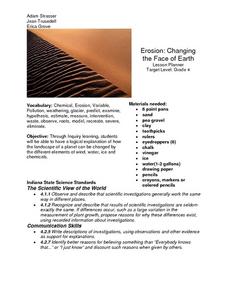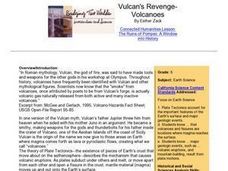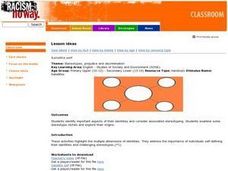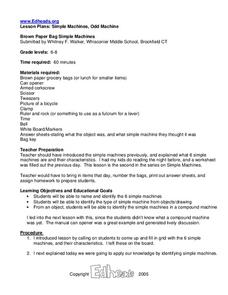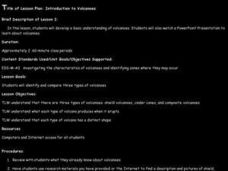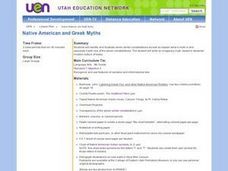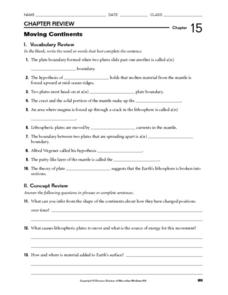Curated OER
Erosion: Changing the Face of Earth
Fourth graders explore how the landscape of the planet can be changed by different elements of wind, water, ice and chemicals through hands-on activities. They examine pictures of areas around town and discuss anything they think is out...
Curated OER
Limu in Your Lunch
Students explore various types of algae found in Hawaii. In this science lesson, students research species of the three types of limu and identify various uses. Students explore products that contain limu.
Curated OER
Vulcan's Revenge-Volcanoes
Sixth graders research various types of volcanoes. They explore the various emissions that come from them. Offer some explanation why some erupt by "quietly" puring lava, while others blast out chunks of rock and clouds of ash and gases.
Curated OER
Country Music Mourns A Legend's Passing
Students investigate the history of country music. They explore various websites, identify the different types of country music, read about members of the Country Music Hall of Fame on their official website, and answer discussion...
Curated OER
Hop on Pop - Short 'o'
Students practice the alphabetic significance of the letter /o/ along with its awareness of phonemes in spoken words. They assess on construction paper the phrase, "We like to hop on top of Pop who's on top of a hot rock" written on it...
Curated OER
Adjunct Materials
Students describe and evaluate adjunct educational materials for their usefulness in social studies classrooms. They identify means of randomly pairing students using social studies content and develop social studies-themed unit plans...
Curated OER
Basin & Range Faulting
High schoolers identify that the crust of the earth is constantly moving and that with the exception of faults accompanied by earthquakes, this rate of movement is far too slow to notice. Then they print a copy of cross-section map A and...
Curated OER
An Introduction to 'Opae 'ula
Students examine the 'opae 'ula. In this science lesson, students observe a live specimen and identify the major body parts. Students construct habitat jars and observe the 'opae 'ula behaviors.
Curated OER
Satellite Self
Students identify important aspects of their identities and consider associated stereotyping. They examine some stereotype cliches and explore their origins.
They address the importance of individuals self-defining their identities and...
Curated OER
Simple Machines, Odd Machines
Students explore simple machines. In this physical science lesson, students identify six simple machines, illustrate each and identify how these machines function or can be combined to create a compound machine.
Curated OER
Simple Machines, Odd Machine
Students investigate simple machines. In this simple machines instructional activity, students identify the six simple machines from an object or drawing. Students also use various objects to identify the simple machines found in a...
Curated OER
Food: Early American Food Cycles Web Quest
Students complete a Web Quest on ways that Native Americans hunted for, harvested, stored, and prepared food and what types of natural foods were eaten. In this early American food cycles lesson, students discover many of the ways early...
Curated OER
Introduction to Volcanoes
Students develop a basic understanding of volcanoes. They watch a PowerPoint Presentation which introduces three types of volcanoes: shield volcanoes, cinder cones, and composite volcanoes.
Curated OER
How Does Your Magma Grow?
Students identify the three types of plate boundaries and the Earth's tectonic plates system. They examine how the Galapagos Islands were formed and hydrothermal vents.
Curated OER
The Extraordinary Life of the Alaskan Tundra
Students investigate the characteristics of the tundra on the North Slope of Alaska. They conduct Internet research, develop a chart of the types of vegetation, plant growth, and fauna found on the tundra, identify examples in their own...
Curated OER
Glaciers
In this glaciers worksheet, learners complete 12 different questions related to glaciers. First, they complete the 2 tables that illustrate the similarities and differences between continental and valley glaciers. Then, students identify...
Curated OER
Understanding a Geological Map
Middle schoolers identify different types of maps and observe a geological map. In this geology lesson students create a replica map of a geological area that includes a key.
Curated OER
Fungi Crossword
In this biology worksheet, students complete a crossword puzzle with 28 questions about fungi. They identify the different parts of a fungus.
Curated OER
Landforms
Second graders identify all the geographical landforms along the pioneer trail. They study, and present to the class, at least one geographical landform along the pioneer trail.
Curated OER
Native American and Greek Myths
Fifth graders identify seven different constellations and explain a myth that accompanies it. As a class, they listen to myths associated with the Greek and Native American cultures. To end the activity, they write their own myth...
Curated OER
Science Italian Style: Eruption!
Young scholars explore ways scientists prepare for a volcanic eruption. They observe films of earthquakes, oil spills, volcanoes and hurricanes. Students perform activities to demonstrate the relationship of viscosity to lava flow. ...
Curated OER
Volcanoes
Students explore the formation of volcanoes. In this earth science lesson, students build their own volcanoes in the lab using different materials. They identify the different types of volcanoes.
Curated OER
Bias Sampling
Students demonstrate how the results of a poll or other scientific study can be biased by selecting special types of people to respond or by asking only certain questions.
Curated OER
Moving Continents
In this moving continents worksheet, students review the different types of plate boundaries, what causes earthquakes, and where volcanoes are formed. This worksheet has 10 fill in the blank and 9 short answer questions.


